Repair Topics
How To Apply Drywall Tape
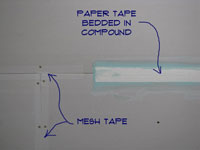 Before you can learn how to apply drywall tape, you need to determine which kind you want to use. There are two types of tape that are commonly used for drywall repairs, one is made from paper, the other is made from fiberglass mesh.
Before you can learn how to apply drywall tape, you need to determine which kind you want to use. There are two types of tape that are commonly used for drywall repairs, one is made from paper, the other is made from fiberglass mesh.
Some related articles are 'Taping and Mudding Drywall', 'How To Patch Drywall' and 'How To Install Drywall', see this information for futher instruction.
Using Paper Drywall Tape
Installing drywall tape with paper tape will require one extra step. First you have to apply mud and wipe the tape down to get it to stick to the drywall. Spread about and eighth of an inch of compound along two opposite sides of the seam or joint.
Cut a piece of paper tape about two or three inches longer than the joint you are taping. Center the tape over the joint. Use a four or a six inch knife to wipe the tape down, pressing the excess mud out from under it. The tape should be fairly tight to the wall. The flatter the better.
Repeat this for the other seams or joints you are working on. Where joints intersect, make sure the tape laps onto the other pieces of tape by at least an inch. Also you need to make sure that there is mud between the layers of tape. Wipe out the excess mud and then walk away. I will repeat that 'WALK AWAY', you have to let it dry.
Do not attempt to coat the joint with compound over wet tape. You will be very angry in a hurry. Find something else to do until the tape dries. Don't blame me, if you had spent the extra couple of dollars on the fiberglass tape, you would not be doing this step. Taping mudding drywall is all about drying time, mesh tape eliminates one drying phase.
To cut the tape hold it in the spot you want to cut it against the wall with a drywall knife. Hold tight and pull the tape, it should tear cleanly at the edge of the knife. Try it a couple of times for practice.
Installing drywall tape when using mesh tape is a little simpler. The mesh tape has some adhesive on it that allows it to stick to the wall. You cut the tape similar to paper tape. You do not have to apply mud to the tape prior to installing it. When you have the tape the way you want it, you coat over it with compound.
How To Install Fiberglass Tape
Fiberglass Mesh Tape sticks to the wall by itself and the holes allow the mud to bleed through and stick to the wall. You can put a first coat of mud on immediately. For taping mudding drywall repair projects this tape is the best.
For small jobs fiberglass tape is preferred, even though it costs more. It saves one step, thus saving time. The exception to this rule is taping inside corners. Fiberglass tape does a poor job in corners. You want to use paper tape instead. For about ten dollars, you can get a roll of each, should last you for a long time on home repair projects.
Fiberglass mesh tape has a self stick feature. You do not need to apply drywall compound to install the tape. Instead, you apply it to the wall at the locations that you need it.
How To Tape and Mud Drywall
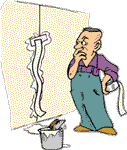 Knowing how to tape and mud drywall can save you a lot of time and money over time. If you own a house, eventually you will need to patch and repair some of the walls and ceilings. This article and the related information will give you all the tools you need to successfully finish drywall projects in your home.
Knowing how to tape and mud drywall can save you a lot of time and money over time. If you own a house, eventually you will need to patch and repair some of the walls and ceilings. This article and the related information will give you all the tools you need to successfully finish drywall projects in your home.
For related information see the articles, 'Troubleshooting Drywall Problems', 'How To Patch Drywall' and 'How To Install Drywall Patches'.
Years ago all walls and ceilings were plastered. The plasterers thought that drywall was a flash in the pan product. Unfortunately for them it has lasted. Drywall introduced two entirely new trades into the industry. Drywall hanging and drywall taping or finishing.
Plasterers have found other occupations in the construction industry, but there are far fewer of them than there are drywallers or sheetrockers. With a little practice and a few inside tips you can do an acceptable job at taping mudding drywall.
Taping and Mudding Drywall - The Steps Involved
This article on taping mudding drywall is informational. It is intended to provide basic how to skills to get a job done. We do not classify this information as a repair. In this series we provide you with information about materials and techniques. The information below gives you a summary of the various things involved. There are several steps, but none of them take very long.
Replacing Damaged Drywall
If you have a hole or large crack in your wall or ceiling, it is likely that you will need to replace some of the drywall. For instructions on removing and installing new drywall for patches, see the article 'Patching Drywall Holes With New Drywall'.
How To Apply Drywall Tape
The first step in taping and mudding drywall is installing the tape. Any time you have a break or crack in the surface paper, you need to bridge it with tape. There are two different kinds of tape that are commonly used for drywall repairs.
The methods for installing them are slightly different. For instructions on installing paper and fiberglass mesh tape, see the article 'How To Apply Drywall Tape'.
Installing Compound on Drywall Joints
After the tape is installed and the mud is dry, you can apply the first and second coat of compound. Most patches will require two and sometimes three coats of compound.
The reason for this is that the compound shrinks as it dries. So to get a smooth surface, you need to apply progressively thinner coats of compound.
You also do not want to try and do too much with each application of compound. For instructions on applying the first and second coat of compound, see the article 'How To Tape Drywall Joints'.
Skim Coating Drywall Seams
Skim coating is a very thin layer of compound that is applied as a final coat. Prior to skim coating, joints are lightly sanded. The skim coat is done by keeping the trowel tight against the surface, allowing the compound to fill any low spots.
For instructions on how and when to apply a skim coat, see the article 'How To Skim Coat Drywall'.
How To Sand Drywall
Sanding is an integral part of any taping and mudding project. A final sanding prior to painting is a must to eliminate any ridges in the compound. Light sanding between coats of compound can also reduce the amount of mud used.
Drywall finishing is a touch trade and skilled professionals are able to reduce the amount of sanding by accurately applying the compound. For the rest of us, we may have to do a bit more sanding to achieve a nice finish. See the articles 'How To Sand Drywall', 'Wet Sanding Drywall' and 'Dustless Drywall Sanding' for information on the various sanding options.
Drywall Taping Tools
There are a few tools you will need to complete a drywall finishing project. However, you may not need too many. See the article on 'Drywall Taping Tools' for information on what the tools do and which ones you need.
Types of Drywall Joint Compound
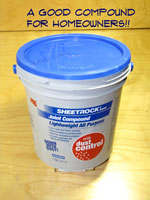
What do you mean, 'types of drywall compound'? It's the white stuff, right? Actually there are several types of drywall compound and depending on what you are doing you may want to be aware of some of them. Most drywall compound comes ready mixed, but some types are still powder mixes.
I am going to run through these quickly, for most of us the type to use is All Purpose. All purpose comes in standard weight, mid weight and light weight forms. All purpose mud can be used for taping and coating. It can also be used for texture if you plan to paint the ceiling.
Taping Mud
Taping mud is used for just that. It has extra glue in it to help it adhere to the wallboard at the joints. It is not as workable for coating the seams and it is harder to sand.
Topping Mud
Topping mud does not have glue in it and is only used for coating seams and texturing. Topping mud is usually whiter and can be used for texturing without painting (that's if you want a white ceiling of course).
All Purpose Compound
As the name implies, this is a general purpose compound that can be used for all phases of a drywall finishing project. This mud has both taping and topping properties and is a good choice if you have a small project. It will dry a light gray if you use it to texture, so you should plan on painting it.
Mid & Light Weight Mud
Mid weight and light weight muds are lighter versions of their standard weight cousins. Light weight muds are easier to work with (especially for amateurs) and much easier to sand. They entrain air into the mud during the manufacturing process.
One of the key advantages or drawbacks, depending on how you look at it is how easy it is to sand. This is a definite plus for novices. However, it is also much easier to groove it and sand too deeply, sometimes exposing the tape. Use caustion when sanding this mud.
Setting or Quick Set Compounds
Setting type muds have chemicals in them that allow them to dry quicker. You purchase them by the proposed drying time, anywhere from 5 minutes on up to 210 minutes. The actual drying times differ depending on a number of factors. These muds are powdered and have to be mixed when used. Do not mix some twenty minute compound and then go off and have your dinner. It will be rock hard in your pan when you come back. There are two kinds of setting muds, the original and a newer easy sand version. Make sure you get the easy sand, only the most skilled tapers can work with the original and most of them hate the stuff. It's main attraction is that it is one of the most durable compounds on the market and can fill some ugly holes.
Dust Control Mud
The newest innovation is a dust control mud. This is a good choice for a home repair. It comes in a light weight version and is a lot less messy than the regular muds. USG makes a light weight all purpose mud with dust control. Definitely the best of all worlds. This is the best all around mud to use for your taping mudding drywall projects. If you are in a hurry get the setting type muds (Durabond is the brand name for USG), 20 or 45 minute will allow you to put multiple coats on a patch in a single day.
Types of Drywall Tape
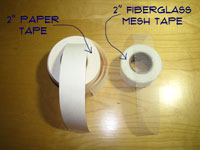
Again there are a number of types of drywall tape. There are only two types that you will probably ever need. There is paper joint tape, usually sold in 250' or 500' rolls. This tape has a ridge down the middle that allows it to be folded and used in corners. Fiberglass mesh tape is the second option. For repair work this is the king.
Both types types of drywall tape come in two inch widths. Wider widths for fiberglass tape are available.
- Paper Tape has to be installed with drywall compound and allowed to dry before it can be coated.
- Fiberglass Mesh Tape sticks to the wall by itself and the holes allow the mud to bleed through and stick to the wall. You can put a first coat of mud on immediately. For taping mudding drywall repair projects this tape is the best.
For small jobs fiberglass tape is preferred, even though it costs more. It saves one step, thus saving time. The exception to this rule is taping inside corners. Fiberglass tape does a poor job in corners. You want to use paper tape instead. For about ten dollars, you can get a roll of each, should last you for a long time on home repair projects.
Mixing Drywall Compound
Mixing drywall compound is always required, even if you have 'ready mixed'. I already mentioned that most compounds come ready mixed. With that said, you usually have to add a small amount of water to get the mud workable. Use the water sparingly, a little bit goes a long way on ready mixed joint compounds.
You can mix a pan full right in the pan or you can use a paddle and a battery drill to mix it in the pail. As a rule the mud should start out stiffer and with each coat get a little thinner. Stiff mud right out of the pail is not good to tape with, you will not get enough of it out from under the tape and it will cause your joints to be heavier.
Powdered muds should be mixed in a pail with a paddle and drill. Mixing them by hand often leaves lumps that will be quite aggravating during your taping mudding drywall operation. Add water gingerly until you get an even workable consistency. There are no gauges to tell you when it is right. When mixing drywall compound, it should have some body, but be workable. Mud that falls off the knife is too thin. If it feels like you are working with concrete on a hot day, it needs some water.
The particular thing you are doing affects how to mix the mud. For taping, you want the mud thinner. When you are 'first coating' or 'bed coating seams and bead, the mud should be stiffer, so that it does not shrink as much. Skim coating as a final pass will require, thinner mud.
How To Lubricate Door Hinges
Before you start lubricating door hinges, you want to have an old rag handy. Be careful with how much spray or grease you apply. You don't need a lot. More is not better in this situation. Wipe up any excess with the rag quickly before it runs and gets on something.
For related topics, see the articles 'Door Hinge Repairs', 'Replacing Door Hinges', 'Adjusting Door Hinges' and 'How To Fix a Door'.
It is best to remove the pin to lubricate a door hinge. You can use a small screwdriver and a hammer to tap the pin out, usually from the bottom of the hinge. Keep the door closed and do one hinge at a time. This way the door will stay supported.
Spray a little silicone spray on the joints in the two hinge leaves where they rub together. Spray a coating onto the pin and tap it back into the hinge. Add a little more spray when you are about half way. Finish tapping the pin into place. Your squeaky door hinge should soon be history.
Repeat this process for the other hinges on the door. The procedure with grease is similar. Coat the pin with a thin layer of grease. Put a small dab of grease on the end and tap the pin back into place.
After you have taken care of all the hinges, open the door. Move it back and forth several times to work the lubricant in. Hopefully, the squeak is gone. Repeat the process if the squeak persists. You want to be sparing with the lubricant, but not too sparing.
Oiling Door Hinges
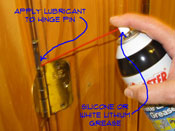 The simplest fix for this problem is oiling door hinges. This is a fairly simple task. The only material you need is five dollar (or less) can of silicone spray. There are a few things to concern yourself with. The first is the potential mess. The other is the lubricant that you decide on.
The simplest fix for this problem is oiling door hinges. This is a fairly simple task. The only material you need is five dollar (or less) can of silicone spray. There are a few things to concern yourself with. The first is the potential mess. The other is the lubricant that you decide on.
Graphite is often recommended for door hardware. It is dry and will not get your keys all oily. In moderation, graphite is a great product and will free up sticky locks. For hinges there are some concerns. The black dry powder can get on surfaces like painted walls and carpet and stain them. This could be a real problem. The hinge works, but the carpet is ruined.
For oiling door hinges, silicone spray or white lithium grease is probably the best choice. Silicone is the easiest, but does not last as long as the grease. When use properly, the mess is minimal. If you decide to use graphite, be careful.
Remove the hinge pins from the hinge one at a time. Apply the lubricant and put the pin back in. When the hinges are lubricated, you should work the door back and forth to work the lubricant in. Repeat if the squeaks or stiffness is persistent. For more information see the articles, 'Squeaky Door Hinges' and 'Fixing Rusty Hinges', for more information on hinge lubrication issues.
WARNING!! Only Remove One Hinge at a Time. The Door Will Fall!!! WARNING!!!
Lubricating a Rusty Hinge
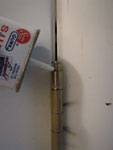 Lubricating a rusty hinge is a good choice when the hinge is still working. Oil will loosen it and quiet it down with a little effort.
Lubricating a rusty hinge is a good choice when the hinge is still working. Oil will loosen it and quiet it down with a little effort.
When a rusty hinge has deep rust, you may want to start by soaking the hinge with penetrating oil. Use a good quality penetrating oil. Apply the oil liberally, without getting it everywhere. Keep a rag handy to wipe up any excess. Allow the oil to soak in before you try working the hinge. You may want to repeat this step a few times with a badly damaged hinge.
After the penetrating oil has freed up the hinge, you can lubricate it. Use a silicone spray or white lithium grease for this task. Keep in mind that an old badly rusted hinge may need repeated treatments.
Lubricating a rusty hinge is easier when you remove the pin. Not all pins are removable, especially on older doors. When this happens, use spray silicone or spray penetrating oil and try to get it in every crevice of the hinge. Work the door back and forth to work the lubricant down into the hinge.
The age and appearance of the rusty hinge may make you decide to replace it. The easiest replacement job is when you have new hinges that are the same size as the old ones. You can replace one hinge at time without taking the door off. Unfortunately, finding replacements for older hinges is difficult. You may need to go online or go to a specialty hardware store. Cost will go up for hinges that are restoration quality.
One other option would be to fit the door for a newer style hinge. This will require some carpentry skills and may be beyond the ability of the average homeowner. You need to take the door off and change the mortises in the door and frame.
Summary
For related topics, see the articles 'Door Hinge Repairs', 'Replacing Door Hinges', 'Adjusting Door Hinges' and 'How To Fix a Door'.
Purchasing Door Hinge Lubricant
A lot of people recommend graphite for squeaky door hinges. Does graphite work? Yes it does, it will stop the squeak. The drawback is that graphite is a black powder and it can make quite a mess if it gets on something like your carpet or painted walls. Graphite can work its way out of the hinge and stain things. So for door hinges, I do not recommend graphite.
Not sure if this is the right problem? See the articles 'Troubleshooting Door Problems' and 'Fixing Door Hinges' for more information.
The two best choices are a silicone spray or white lithium grease. My preference it the silicone spray. It is colorless and can be used sparingly. You may have to use it more often than grease, but it is less messy and a little easier to use. Purchase a spray can of silicone spray, one that is suitable for door hardware. It should have one of those long red tubes taped to the side of the can.
You can also use white lithium grease. You will have to take the pin out of the hinge to use it. You will also have to watch for excess seeping out of the hinge for a couple of days. Other things like three in one oil and machine oil will also work. Caution needs to be exercised when using oils, don't use to much.
How To Fix Squeaky Door Hinges
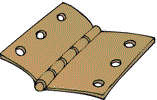 Squeaky door hinges are right up there with dripping faucets on the irritation scale. The squeak develops over time until you can't stand it and something needs to be done. Dealing with a noisy hinge should be an easy thing to fix. Some suitable lubricant is all you need.
Squeaky door hinges are right up there with dripping faucets on the irritation scale. The squeak develops over time until you can't stand it and something needs to be done. Dealing with a noisy hinge should be an easy thing to fix. Some suitable lubricant is all you need.
For related information see 'Troubleshooting Door Problems', 'Repairing Door Hinges', 'Adjusting Interior Doors' and 'How To Adjust Exterior Doors'.
Door hinges are a moving part. They are made of two pieces of flat metal that have notched tabs of metal. These tabs interlock with the tabs on the other side of the hinge and are wrapped around a pin that hold them together. When the door opens and closes, the plates rub against each other and against the pin. When the grease or graphite wears away you will get metal rubbing against metal. That's when the squeaks start.
There is no point in putting off this repair. It should only take a few minutes. In five minutes or less you can quit cringing every time someone opens the door.
Fixing Squeaky Door Hinges - Information
What Can You Save?
A service man will likely charge you $50 to $75 to take care of this problem. This is mostly due to the fact that he has to spend time driving there.
How Hard Could It Be?
Fixing squeaky door hinges is pretty simple and does not take much effort.
Check the Simple Things!
This is already the simplest repair you can make with a door hinge. There is not simpler task to perform.
What Can Go Wrong?
Getting oil all over the door and wall is probably the biggest problem you will face. Use the lubricant sparingly. Always keep a rag handy when you are using oil and other lubricants.
Tight Squeaking Door Hinges
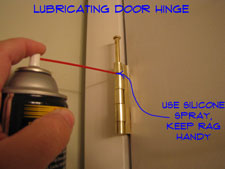 Tight squeaking door hinges are pretty aggravating. Most of the time, you can fix them with a little oil.
Tight squeaking door hinges are pretty aggravating. Most of the time, you can fix them with a little oil.
Try lubricating the hinges first. Use a recommended silicone spray, oil or grease made for this purpose. You can use a punch and a hammer to drive the pin out, (usually from the bottom of the hinge up, unless it was installed upside down). For doors with only two hinges, leave the pins in about halfway. Keep a rag handy and apply the lubricant sparingly, but in enough quantity to solve the problem. Watch for drips and oozing. Replace the pin and open and close the door several times, working the lubricant in.
Are the hinges rusted or painted beyond what a little silicone spray can take care of? Replacing them is easy if you get the same size. A door with only two hinges will need to be taken off before the hinges can be changed. Open the door and put something under the bottom to support it (a block of wood, book, not your toe). Unscrew the bottom hinge first and then the top. Hang onto the door when you release the last screw. For solid core or wood doors you may want to get some help when you take the door off. Lean the door against the wall and finish removing the hinges.
Obtain enough replacement hinges for the door, usually three. Change them one at a time. You may need a chisel or knife to get them loose if they have been painted in place over time. Replacing the hinges, even if you do them one at a time, is repairing a prehung interior door. Well done!
Loosening Tight Door Hinges
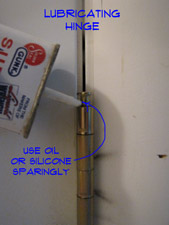 Before you consider replacing the hinges, try loosening tight door hinges with lubricant. Use a recommended silicone spray, oil or grease made for this purpose. You can use a punch and a hammer to drive the pin out, (usually from the bottom of the hinge up, unless it was installed upside down).
Before you consider replacing the hinges, try loosening tight door hinges with lubricant. Use a recommended silicone spray, oil or grease made for this purpose. You can use a punch and a hammer to drive the pin out, (usually from the bottom of the hinge up, unless it was installed upside down).
Keep a rag handy and apply the lubricant sparingly, but in enough quantity to solve the problem. Watch for drips and oozing. Replace the pin and open and close the door several times, working the lubricant in.
One or all of the hinges could need attention. Only take one pin out at a time. Taking out two or three will cause the door to fall and possibly damage it. Only take all the pins out when you are prepared to remove the door. Loosening tight door hinges by lubricating the pins may be a maintenance item that needs to be repeated periodically.
Are the hinges rusted or painted beyond what a little silicone spray can take care of? Replacing them is easy if you get the same size. Remove the middle hinge and take it with you to match up at the hardware store. Obtain enough replacement hinges for the door, usually three.
Change them one at a time. You may need a chisel or knife to get them loose if they have been painted in place over time. Replacing the hinges, even if you do them one at a time qualifies as a successful entry door repair.
Troubleshooting Squeaking Door Hinges
In Step One the article 'Purchasing Door Hinge Lubricant', helped you to make sure that you get the right oil or grease for your door hinges. Most home supply or hardware stores have what you need.
'Lubricating Door Hinges' is the article that covers the actual oiling of the door hinges. It is a pretty easy job, when you set aside the mess.
Sometimes the door is out of adjustment and causing the door to bind. When this happens, oil alone may not solve the problem. See the article 'How To Adjust Door Hinges' for information and instructions on this repair.
Summary
Fixing a squeaky door hinge should not have been too much trouble for you. You have to take the pins out to apply the lubricant. You put them back in and that should take care of the problem. Is your door quiet now? Good, you are done with this project.
If you are a homeowner you have other projects you need to attend to. Since this one was so easy you are probably inspired to attempt something else.


